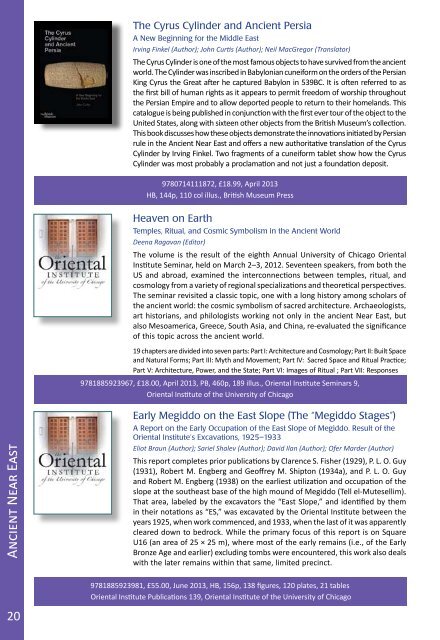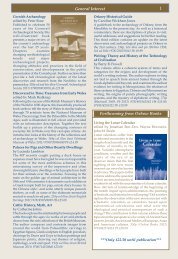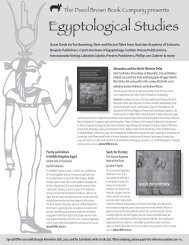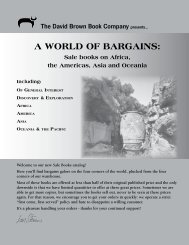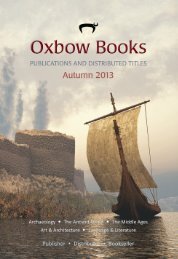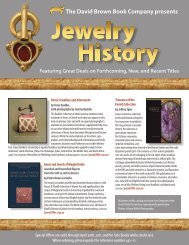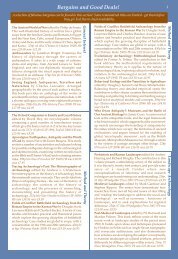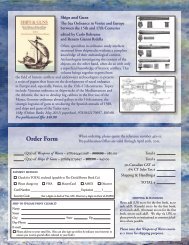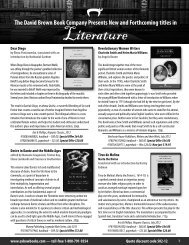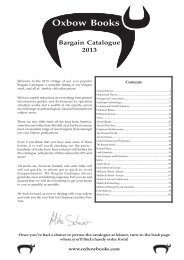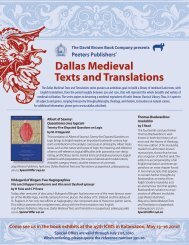Oxbow Spring 2013.pdf - Oxbow Books
Oxbow Spring 2013.pdf - Oxbow Books
Oxbow Spring 2013.pdf - Oxbow Books
You also want an ePaper? Increase the reach of your titles
YUMPU automatically turns print PDFs into web optimized ePapers that Google loves.
The Cyrus Cylinder and Ancient Persia<br />
A New Beginning for the Middle East<br />
Irving Finkel (Author); John Curtis (Author); Neil MacGregor (Translator)<br />
The Cyrus Cylinder is one of the most famous objects to have survived from the ancient<br />
world. The Cylinder was inscribed in Babylonian cuneiform on the orders of the Persian<br />
King Cyrus the Great after he captured Babylon in 539BC. It is often referred to as<br />
the first bill of human rights as it appears to permit freedom of worship throughout<br />
the Persian Empire and to allow deported people to return to their homelands. This<br />
catalogue is being published in conjunction with the first ever tour of the object to the<br />
United States, along with sixteen other objects from the British Museum’s collection.<br />
This book discusses how these objects demonstrate the innovations initiated by Persian<br />
rule in the Ancient Near East and offers a new authoritative translation of the Cyrus<br />
Cylinder by Irving Finkel. Two fragments of a cuneiform tablet show how the Cyrus<br />
Cylinder was most probably a proclamation and not just a foundation deposit.<br />
9780714111872, £18.99, April 2013<br />
HB, 144p, 110 col illus., British Museum Press<br />
Heaven on Earth<br />
Temples, Ritual, and Cosmic Symbolism in the Ancient World<br />
Deena Ragavan (Editor)<br />
The volume is the result of the eighth Annual University of Chicago Oriental<br />
Institute Seminar, held on March 2–3, 2012. Seventeen speakers, from both the<br />
US and abroad, examined the interconnections between temples, ritual, and<br />
cosmology from a variety of regional specializations and theoretical perspectives.<br />
The seminar revisited a classic topic, one with a long history among scholars of<br />
the ancient world: the cosmic symbolism of sacred architecture. Archaeologists,<br />
art historians, and philologists working not only in the ancient Near East, but<br />
also Mesoamerica, Greece, South Asia, and China, re-evaluated the significance<br />
of this topic across the ancient world.<br />
19 chapters are divided into seven parts: Part I: Architecture and Cosmology; Part II: Built Space<br />
and Natural Forms; Part III: Myth and Movement; Part IV: Sacred Space and Ritual Practice;<br />
Part V: Architecture, Power, and the State; Part VI: Images of Ritual ; Part VII: Responses<br />
9781885923967, £18.00, April 2013, PB, 460p, 189 illus., Oriental Institute Seminars 9,<br />
Oriental Institute of the University of Chicago<br />
Ancient Near East<br />
20<br />
Early Megiddo on the East Slope (The “Megiddo Stages”)<br />
A Report on the Early Occupation of the East Slope of Megiddo. Result of the<br />
Oriental Institute’s Excavations, 1925–1933<br />
Eliot Braun (Author); Sariel Shalev (Author); David Ilan (Author); Ofer Marder (Author)<br />
This report completes prior publications by Clarence S. Fisher (1929), P. L. O. Guy<br />
(1931), Robert M. Engberg and Geoffrey M. Shipton (1934a), and P. L. O. Guy<br />
and Robert M. Engberg (1938) on the earliest utilization and occupation of the<br />
slope at the southeast base of the high mound of Megiddo (Tell el-Mutesellim).<br />
That area, labeled by the excavators the “East Slope,” and identified by them<br />
in their notations as “ES,” was excavated by the Oriental Institute between the<br />
years 1925, when work commenced, and 1933, when the last of it was apparently<br />
cleared down to bedrock. While the primary focus of this report is on Square<br />
U16 (an area of 25 × 25 m), where most of the early remains (i.e., of the Early<br />
Bronze Age and earlier) excluding tombs were encountered, this work also deals<br />
with the later remains within that same, limited precinct.<br />
9789491431074, £42, August 2012<br />
9781885923981, £55.00, June 2013, HB, 156p, 138 figures, 120 plates, 21 tables<br />
HB, 475p, Groningen Archaeological Studies 19, Barkhuis<br />
Oriental Institute Publications 139, Oriental Institute of the University of Chicago


